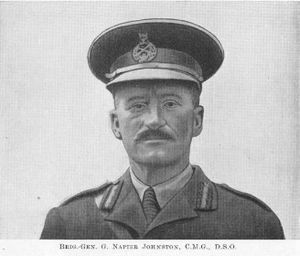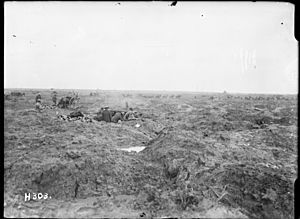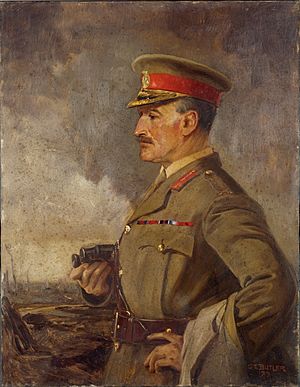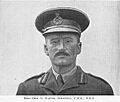George Napier Johnston facts for kids
Quick facts for kids
George Napier Johnston
|
|
|---|---|

Portrait of Brigadier-General George Napier Johnston, NZEF
|
|
| Born | 20 August 1867 Quebec, Canada |
| Died | 3 April 1947 (aged 79) Dar es Salaam, Tanganyika (Tanzania) |
| Allegiance | United Kingdom |
| Service/ |
British Army New Zealand Military Forces |
| Years of service | 1884–1924 |
| Rank | Major-General |
| Battles/wars | First World War |
| Awards | Companion of the Order of the Bath Companion of the Order of St Michael and St George Distinguished Service Order Mentioned in Despatches (8) Officer of the Legion of Honour (France) |
Major-General George Napier Johnston (born August 20, 1867 – died April 3, 1947) was an important officer in the British Army. He also served with the New Zealand Military Forces during the First World War.
Born in Quebec, Canada, Johnston joined the British Army in 1888. He taught artillery and worked in British India. In 1904, he spent three years helping the New Zealand military. He returned to New Zealand in 1911 as an artillery expert. When World War I began, he joined the New Zealand Expeditionary Force (NZEF).
He led artillery units during the Gallipoli Campaign and on the Western Front. He received many awards for his bravery and leadership. After the war, he briefly led the New Zealand Division in Germany. He then returned to the British Army. Johnston passed away in Dar es Salaam, Tanzania, when he was 79 years old.
Contents
Early Life and Military Start
George Napier Johnston was born on August 20, 1867, in Quebec, Canada. He started at the Royal Military College of Canada in 1884. After four years, he graduated and joined the Royal Garrison Artillery of the British Army. For the next ten years, he worked in various places. In 1898, he became a captain.
Johnston spent four years in India teaching artillery. In 1904, he was sent to help the New Zealand Military Forces. He worked with artillery units for three years. Then, he went back to the United Kingdom. He returned to New Zealand in 1911. There, he became the Director of Artillery.
World War I Service
When the First World War began, Johnston was a major. He was also the Inspector of Artillery. The New Zealand government decided to create the New Zealand Expeditionary Force (NZEF). This force would fight overseas. Johnston was chosen to lead the Field Artillery Brigade. He left Wellington with the main NZEF group in October 1914. The NZEF was supposed to go to the Western Front. But, Turkey joined the war, so they went to Egypt instead.
Fighting at Gallipoli
In 1915, the New Zealand and Australian Division was formed. Johnston became the commander of its artillery. His unit had only 16 guns, including four howitzers. This was much less than a normal division would have. Even with few guns and limited ammunition, his work was highly praised. This was during the tough Gallipoli Campaign. In October 1915, before the Allies left Gallipoli, he was made a temporary brigadier-general.
On the Western Front
When the New Zealand Division was created in 1916, Johnston became its artillery commander. He was promoted to lieutenant-colonel but kept his temporary rank of brigadier-general. The division moved to France in April 1916. His artillery supported the infantry during trench raids. Two months after arriving in France, he received the Distinguished Service Order (DSO). This award was for his excellent service in the field.
In September 1916, his artillery saw a lot of action. This was during the Battle of the Somme. They supported the troops for 56 days straight. They provided strong barrages and counter-fire. This helped the infantry reach most of their goals. Johnston's skill was a big reason for this success. In May 1917, he received the Croix de Officier of the Légion d'honneur from France. This French award is rare for New Zealanders. Fewer than 100 have received it. Johnston was one of only 14 New Zealand military members to get it during the war.
Johnston's artillery did very well during the Battle of Messines. They also performed well at the start of the Third Battle of Ypres. They overcame difficult conditions during the New Zealand Division's attack at Broodseinde on October 4, 1917. The ground became very muddy before the First Battle of Passchendaele. Johnston warned Major-General Andrew Russell, the division commander. He said his artillery was not ready. The mud made it hard to position the guns. It also stopped enough ammunition from reaching them. When the division attacked on October 12, they could not achieve their main goals.
The Hundred Days' Offensive started in August 1918. The fighting changed from trench warfare to more open battles. German forces were retreating. Johnston had to change his artillery tactics. He created a system where artillery batteries moved with the advancing infantry. A senior officer at brigade headquarters would guide them. They would move forward in stages. This allowed them to keep providing fire support as the division advanced. Other British divisions' artillery was less mobile. They could not support fast forward movement as well.
By the end of the war, Johnston had been mentioned in official reports eight times. He was also made a Companion of the Order of St Michael and St George. In early 1919, he was promoted to temporary major-general. He commanded the New Zealand Division while it was in Germany. They were there for occupation duty. He oversaw the division being formally ended later that year. After leaving the NZEF, he rejoined the British Army.
Life After the War
When Johnston returned to the British Army, he went back to his rank of lieutenant-colonel. He was appointed Commander Royal Artillery for the 52nd (Lowland) Division. In April 1920, he was promoted to colonel. He stayed with this division until he retired from the military in 1924. He retired with the honorary rank of brigadier-general. While with the 52nd Division, he wrote an introduction for a book about the New Zealand Artillery in World War I. He also became a Companion of the Order of the Bath. George Napier Johnston died on April 3, 1947, in Dar es Salaam, which is now in Tanzania.
Images for kids






